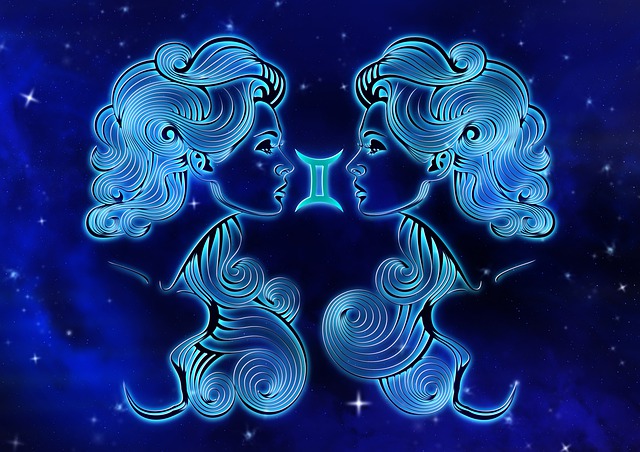*Whether astrology is science or magic, we’re open to most things, if they may be of benefit. ~ Ed.
Astronomically, and in sidereal, the sun is moving through Gemini right now.
The sun represents our collective soul. It high-“lights” energetic currents that you might have been picking up.
All 12 zodiacal dimensions stand for specific themes that can offer us teachings for inner growth—independent of the sun of your birth chart being in Gemini or not.
The mythology most referenced with Gemini concerns the twins, Castor and Pollux. One of them was mortal, Castor, and one immortal, Pollux. When Castor died, Pollux was so distraught that he begged his father Zeus to be able to die, too. Touched by the sincerity of his love, Zeus made both of them immortal by placing them together in the heavens so they would never be separated again.
The story portrays the inherent wish of consciousness (that in us which is immortal) to realize itself while being in physical form (mortality).
When you look at ancient pictorial depictions of Gemini, you see one of the twins with a bow and a lyre, and one of them with a sickle or club. One twin represented the practical aspect of life, one the artistic/spiritual.
Many other dualities were referenced with Gemini over time: higher and lower self, human self and divinity, mortal and immortal, shadow/darkness and light, matter and consciousness, earth and heaven, science and spirituality, male and female (twin flames), sun and moon, etc. Ultimately, all ancient teachings, no matter if they talk about your energetics or dualities in mind/perception, highlight one ultimate step: transcending the duality.
Let’s dive a bit deeper into different teachings on duality:
1. In yogic philosophy, the fundamental “problem” of duality is not only that we adopt a “me against them” mentality, but also that we divide the world into that which we “like” and that which we “don’t like.” That alone does not lead to suffering, but the wish to escape that which we don’t like (in yoga philosophy called dveṣa) and the wish to get more of that which we like (in yoga called rāga), does.
Think of many of the modern spiritual teachings that hope to influence reality by the power of your will. Even if we get more of what we like in life, does it mean we will be happier? The teachings of yoga are not about an escape from life, but about practicing acceptance and tolerance for all facets of life. We are learning to be okay with the fact that both happy moments, as well as sad moments, come and go.
2. Acceptance ultimately leads to transcendence. In the fourth chapter of the Yogasūtra (YS 4.7.), Patañjali talks about the yogini’s actions being neither white nor black. Yes, you can imagine this like in “Star Wars,” with the Jedis. Only that, now, there is no more black and white—there are no more sides.
Usually, there are good actions someone takes to be appreciated, or bad actions someone takes to hurt others. The yogi becomes colorless. He or she takes action from a place of inner connection but is not attached to outcomes anymore (getting this or avoiding this). It means you act from a deep inner conviction and connection to consciousness, but it doesn’t matter if you are celebrated for it or despised.
3. In the Tarot, Gemini is represented by number six, called “the lovers.” It symbolizes the garden of Eden and the “fall” into the negative perception of duality. This fall is seen as the beginning point (of human suffering). Transcending the duality by radically accepting dualities inside and outside of us, is seen as the “way out” (of suffering).
P.D. Ouspensky writes about it:
“‘This picture you see, is a picture of temptation and fall,’ said the voice. ‘What constitutes the fall? Do you understand its nature?’ ‘Life is so good,’ I said, ‘and the world so beautiful, and this man and woman wanted to believe in the reality of the world and of themselves. They wanted to forget service and take from the world what it can give. So they made a distinction between themselves and the world. They said, ‘We are here, the world is there.’ And the world separated from them and became hostile.'”
“‘This fall, this first ‘sin of man,’ repeats itself perpetually, because man continues to believe in his separateness and in the present. And only by means of great suffering can he liberate himself from the control of time and return to eternity—leave darkness and return to light.'”
4. What is true for life and outside of you, is also true for inside of you (again separation doesn’t really exist). The fourth chapter of the Haṭhayogapradīpika (4.17), talks about the two main Nāḍī-s Iḍa and Pingalā creating the division of time in the form of day and night. Only when the energy moves through the Suṣumnā (the middle channel), will the yogic practitioner enter the state of timelessness.
Maybe best to remember is that our choice ultimately brings the duality into existence in the first place.
Or, as Lao Tzu writes in the Tao Te Ching:
“When people see some things as beautiful,
other things become ugly.
When people see some things as good,
other things become bad.
Being and non-being create each other.
Difficult and easy support each other.
Long and short define each other.
High and low depend on each other.
Before and after follow each other.
Therefore the Master
acts without doing anything
and teaches without saying anything.
Things arise and she lets them come;
things disappear and she lets them go.
She has but doesn’t possess,
acts but doesn’t expect.
When her work is done, she forgets it.
That is why it lasts forever.”











Read 0 comments and reply